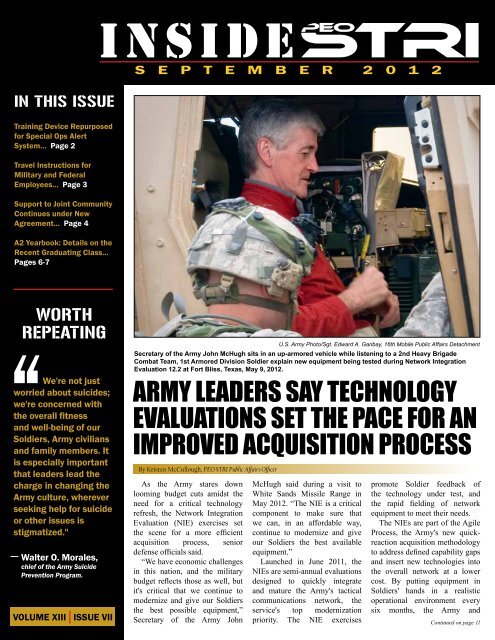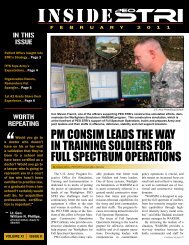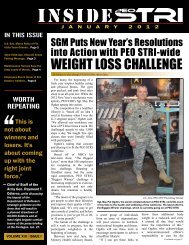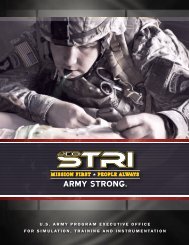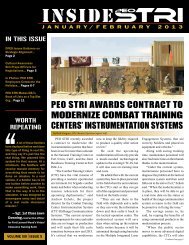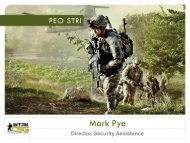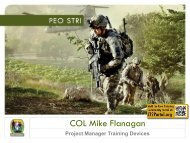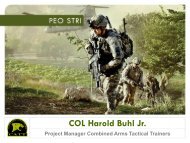Travel Terms Decoded - PEO STRI - U.S. Army
Travel Terms Decoded - PEO STRI - U.S. Army
Travel Terms Decoded - PEO STRI - U.S. Army
You also want an ePaper? Increase the reach of your titles
YUMPU automatically turns print PDFs into web optimized ePapers that Google loves.
In thIs Issue<br />
training Device repurposed<br />
for Special Ops Alert<br />
System... page 2<br />
travel Instructions for<br />
Military and Federal<br />
Employees... page 3<br />
Support to Joint Community<br />
Continues under New<br />
Agreement... page 4<br />
A2 Yearbook: Details on the<br />
recent Graduating Class...<br />
pages 6-7<br />
Worth<br />
repeatIng<br />
We're not just<br />
worried about suicides;<br />
we're concerned with<br />
the overall fitness<br />
and well-being of our<br />
Soldiers, <strong>Army</strong> civilians<br />
and family members. It<br />
is especially important<br />
that leaders lead the<br />
charge in changing the<br />
<strong>Army</strong> culture, wherever<br />
seeking help for suicide<br />
or other issues is<br />
stigmatized."<br />
Walter O. Morales,<br />
chief of the <strong>Army</strong> Suicide<br />
Prevention Program.<br />
VOLUME XIII ISSUE VII<br />
InsIde<br />
S E p t E M b E r 2 0 1 2<br />
Secretary of the <strong>Army</strong> John McHugh sits in an up-armored vehicle while listening to a 2nd Heavy Brigade<br />
Combat Team, 1st Armored Division Soldier explain new equipment being tested during Network Integration<br />
Evaluation 12.2 at Fort Bliss, Texas, May 9, 2012.<br />
By Kristen McCullough, <strong>PEO</strong> <strong>STRI</strong> Public Affairs Officer<br />
As the <strong>Army</strong> stares down<br />
looming budget cuts amidst the<br />
need for a critical technology<br />
refresh, the Network Integration<br />
Evaluation (NIE) exercises set<br />
the scene for a more efficient<br />
acquisition process, senior<br />
defense officials said.<br />
“We have economic challenges<br />
in this nation, and the military<br />
budget reflects those as well, but<br />
it's critical that we continue to<br />
modernize and give our Soldiers<br />
the best possible equipment,”<br />
Secretary of the <strong>Army</strong> John<br />
U.S. <strong>Army</strong> Photo/Sgt. Edward A. Garibay, 16th Mobile Public Affairs Detachment<br />
<strong>Army</strong> LeAders sAy TechnoLogy<br />
evALuATions seT The PAce for An<br />
imProved AcquisiTion Process<br />
McHugh said during a visit to<br />
White Sands Missile Range in<br />
May 2012. “The NIE is a critical<br />
component to make sure that<br />
we can, in an affordable way,<br />
continue to modernize and give<br />
our Soldiers the best available<br />
equipment.”<br />
Launched in June 2011, the<br />
NIEs are semi-annual evaluations<br />
designed to quickly integrate<br />
and mature the <strong>Army</strong>'s tactical<br />
communications network, the<br />
service's top modernization<br />
priority. The NIE exercises<br />
promote Soldier feedback of<br />
the technology under test, and<br />
the rapid fielding of network<br />
equipment to meet their needs.<br />
The NIEs are part of the Agile<br />
Process, the <strong>Army</strong>'s new quickreaction<br />
acquisition methodology<br />
to address defined capability gaps<br />
and insert new technologies into<br />
the overall network at a lower<br />
cost. By putting equipment in<br />
Soldiers' hands in a realistic<br />
operational environment every<br />
six months, the <strong>Army</strong> and<br />
Continued on page 11
new soLdier moniToring sysTem<br />
sAves Lives during TrAining exercises<br />
By Rick Gregory, A<strong>PEO</strong> Business Operations Support Staff<br />
While the majority of <strong>PEO</strong> <strong>STRI</strong>’s<br />
fielded training aids, devices, simulators and<br />
simulations are used to train Soldiers on how<br />
to survive on the battlefield, one system is<br />
being fielded this month to help save lives<br />
during training exercises. Called the Soldier<br />
Monitoring System (SMS), it was developed,<br />
procured and fielded as the result of a Soldier’s<br />
unfortunate death during a special operations<br />
training exercise in 2010.<br />
The Soldier, a Special Forces candidate,<br />
didn’t return following a 10-hour solo land<br />
navigation course. Having not used his<br />
safety equipment—a whistle, strobe light and<br />
reflective belt attached to his pack—it took a<br />
search using more than 475 Soldiers to locate<br />
his body.<br />
To prevent a recurrence of the tragic incident,<br />
<strong>Army</strong> leadership directed the implementation<br />
of a persistent Soldier monitoring system. PM<br />
TRADE answered the call by transferring an<br />
Initial Homestation Instrumentation Training<br />
System (I-HITS) from Alaska to Fort Bragg,<br />
N.C. During its first time in use, the I-HITS<br />
proved its worth when three injured Soldiers<br />
were quickly located and provided medical<br />
attention within an hour.<br />
Since then, PM CATT’s Product Manager for<br />
Special Operations Forces Training Systems,<br />
SOF Ground team, led by Rick Matthews,<br />
has procured and fielded an objective solution<br />
called the Soldier Monitoring System, or SMS.<br />
The new system is a radio frequency-based<br />
tracking system where every Soldier carries a<br />
Soldier Wireless Device (SWD) that transmits<br />
back to the Exercise Control (EXCON) station.<br />
Some of the system specifications are:<br />
• System Weight: 1.5 pounds with the extendedlife<br />
battery.<br />
• 48 hours of battery life with the radio signal<br />
refresh rate every 60 seconds; 24 hours at 30<br />
seconds.<br />
• A “No Motion” alert is sent to the EXCON<br />
if the SWD remains motionless for a<br />
programmed period of time.<br />
• A “Boundary” alert is sent to the EXCON if<br />
the SWD goes outside a designated boundary.<br />
• The SWD has a “Panic Button” that the Soldier<br />
can easily activate in case of an emergency.<br />
• All EXCON data can be pushed to hand-held<br />
tracking tablets to facilitate Soldier location<br />
2<br />
InsIde sTRI september 2012<br />
U.S. <strong>Army</strong> photo/Staff Sgt. Russell Lee Klika<br />
A Special Forces qualifications course student<br />
prepares to conduct a field exercise.<br />
U.S. <strong>Army</strong> photo<br />
The Soldier Monitoring System's radio device<br />
carrying case hold up to 13 radios.<br />
and command and control.<br />
William Sanchez, project director and lead<br />
engineer for the SMS effort, explained that “the<br />
cadre can program the system settings, like the<br />
boundaries and SWD refresh rate, to meet the<br />
requirements of a specific training event. This<br />
flexibility allows the commander to tailor the<br />
system to his or her training and safety needs”.<br />
The entire system can be completely set up<br />
in less than two hours and, using a bar code<br />
scanner, the devices are distributed quickly and<br />
efficiently to the Soldiers. SMS can handle<br />
more than 400 devices without degrading the<br />
coverage area while providing a wealth of<br />
monitoring data back to the EXCON station.<br />
“It has a small footprint, is logistically simple<br />
to maintain, yet offers the special operations<br />
community an unparalleled capability,” said<br />
Sanchez.<br />
Lt. Col. Richard Haggerty, product manager<br />
for SOF Training Systems, said he is proud of<br />
the team’s accomplishments in such a short<br />
period of time.<br />
“The small and agile SMS team, cooperating<br />
U.S. <strong>Army</strong> photo<br />
The Soldier Monitoring System's antenna<br />
assembly's mast is extended to the maximum 80<br />
foot height.<br />
with many different organizations, was able to<br />
develop an asymmetric acquisition strategy,<br />
secure funding and execute an on-site Limited<br />
User Acceptance with 50 devices in just over<br />
12 months. In acquisition circles this is almost<br />
unheard of.”<br />
By the end of the calendar year, the SMS<br />
will be used in supporting the operations and<br />
exercises of four different organizations, all<br />
with different training requirements, at Fort<br />
Bragg, N.C., Yuma, Ariz., and Fort Campbell,<br />
Ky.
<strong>Travel</strong> Tips to Know Before you go<br />
By John Andino and Cindy Capote, <strong>PEO</strong> <strong>STRI</strong> <strong>Travel</strong> Office<br />
Before You Go<br />
• All travel authorizations must<br />
include a justification stating that the<br />
meeting could not have occurred via<br />
telecommunication means; i.e., “Alternate<br />
communications means, such as a secure<br />
video teleconference or other web-based<br />
communication, have been considered and<br />
deemed insufficiently able to accomplish the<br />
travel objectives.” The justification can be<br />
added to the “Comments to the Approving<br />
Official” portion of the authorization.<br />
• It is mandatory when selecting a flight to<br />
choose the contract carrier.<br />
• When selecting a flight, ensure that<br />
the departing airport code is “MCO” for<br />
Orlando International Airport and not<br />
“ORL,” the code for the Orlando Executive<br />
Airport.<br />
• If you’re traveling OCONUS and your<br />
flight lands a day or more after your<br />
departure date, ensure that you mark the day<br />
you arrive at your destination, and not the<br />
day you depart on the airplane, so the per<br />
diem entitlements are accurately reflected.<br />
• After your authorization is approved,<br />
tickets will be issued three business days<br />
prior to travel.<br />
• A traveler should not leave for the<br />
airport without having their E-Invoice and<br />
travel orders in hand. You can print your<br />
E-Invoice by going to www.virtuallythere.<br />
com. Log in with your reservation locator,<br />
last name and email address.<br />
• A traveler can be reimbursed for up to<br />
two checked bags.<br />
<strong>Travel</strong> <strong>Terms</strong> <strong>Decoded</strong><br />
DTS - Defense <strong>Travel</strong> System, www.defensetravel.osd.mil, the<br />
website for DoD travelers<br />
JTR - Joint <strong>Travel</strong> Regulation for civilian personnel<br />
JFTR - Joint Federal <strong>Travel</strong> Regulation for military personnel<br />
While You’re There<br />
• Changing flights while on travel should<br />
be made through SATO at 800-788-7286<br />
and not with the airlines.<br />
• Rental car companies are going “smoke<br />
free.” You are responsible to check with the<br />
company regarding<br />
their smoking<br />
policy prior to<br />
renting the vehicle.<br />
Penalties are not a<br />
reimbursable cost<br />
by the government.<br />
• Pre-charging for<br />
fuel is prohibited.<br />
• Baggage tips are not reimbursable<br />
for civilian personnel, however military<br />
personnel can be reimbursed per the JFTR.<br />
• Tips for transportation—i.e., taxi, shuttle<br />
and limo—are reimbursable for all travelers.<br />
Certain tips are not reimbursable—i.e.,<br />
maid, doorman, gym and concierge—<br />
because the fee is calculated within the<br />
incidental expenses.<br />
• Laundry expenses are not authorized<br />
OCONUS. Laundry expenses are<br />
reimbursed in CONUS. Fees are<br />
reimbursable for civilian personnel after<br />
four consecutive nights of travel. Military<br />
personnel can be reimbursed $2 per day<br />
after seven consecutive nights. For example,<br />
Lt. Col. Doe travels for eight consecutive<br />
nights; he may be reimbursed $16. If he<br />
travels six consecutive nights, he would not<br />
be reimbursed.<br />
When You Return<br />
• Review your travel voucher thoroughly;<br />
your signature certifies that all the<br />
information is accurate.<br />
• When entering baggage fees into your<br />
DTS travel voucher, create an expense for<br />
“Baggage Fee” under non-mileage expenses<br />
rather than selecting the “Excess Baggage”<br />
option.<br />
• Check for and remove duplicate expenses,<br />
typically charged under airfare, rental car<br />
and lodging, or Commercial <strong>Travel</strong> Office<br />
(CTO) fees.<br />
• Hotel taxes in CONUS should be separate<br />
from the lodging rate and entered under<br />
the non-mileage expenses. For OCONUS<br />
travel, hotel taxes are not a separate expense<br />
and should be shown under the lodging per<br />
diem entitlements.<br />
• Ensure that your lodging and car rental<br />
receipts show a $0.00 balance.<br />
• The E-Invoice is a required receipt.<br />
• If you claim a conference fee and meals<br />
are provided, ensure that you mark which<br />
meals were provided under the per diem<br />
entitlements.<br />
Questions?<br />
Email DTSQuery@us.army.mil<br />
Look out for the <strong>PEO</strong> <strong>STRI</strong><br />
travel policy coming soon!<br />
CONUS - the 48 contiguous U.S. states, including the District of<br />
Columbia<br />
OCONUS - all the areas outside of CONUS<br />
InsIde sTRI september 2012<br />
3
sTri inks memorandum of Agreement<br />
with department of defense Joint staff<br />
By Rick Gregory, A<strong>PEO</strong> Business Operations Support Staff<br />
When <strong>Army</strong> Chief of Staff General Raymond<br />
Odierno cased the colors of the U.S. Joint Forces<br />
Command (USJFCOM) last year, he said it does<br />
not mean the end of joint operations.<br />
“Our warfighting commanders will continue to<br />
benefit from the timely coordinated deployment<br />
of joint operational capable forces, synchronized<br />
training of those forces and prioritized integrated<br />
capabilities to support them,” he said.<br />
He added that many of the missions performed<br />
by personnel from the disestablished USJFCOM,<br />
his last command before becoming the <strong>Army</strong><br />
chief of staff, would remain, but under new<br />
management in other agencies.<br />
That promise became reality in August 2011<br />
with the formal transition of people and key<br />
functions to the Joint Staff, and a key support<br />
element remains in place as well. In June 2012,<br />
the previous formal relationship between <strong>PEO</strong><br />
<strong>STRI</strong> and USJFCOM was continued with a<br />
Memorandum of Agreement (MOA) endorsed<br />
between <strong>PEO</strong> <strong>STRI</strong> and the Joint Staff, J7<br />
Deputy Directorate for Joint and Coalition<br />
Warfighting (JCW), the Department of Defense<br />
organization that assumed many of USJFCOM’s<br />
responsibilities.<br />
Signed by Dr. Jim Blake, <strong>PEO</strong> <strong>STRI</strong>, and<br />
Vice Adm. William Gortney, director of the<br />
Joint Staff, the MOA designates <strong>PEO</strong> <strong>STRI</strong><br />
as one of the primary service organizations<br />
for contracting, acquisition and materiel<br />
development support to the J7 JCW.<br />
Located in Suffolk, Va., and led by Maj. Gen.<br />
Frederick Rudesheim, the J7 JCW mission is to<br />
support the training and development of joint,<br />
interagency and multinational capabilities to<br />
meet the present and future operational needs<br />
of joint and combined forces.<br />
Their multinational collaboration and<br />
integration involves 19 nations with bilateral<br />
MOAs including Australia, Canada, Czech<br />
Republic, Denmark, Finland, Germany,<br />
Hungary, Italy, Japan, Jordan, Morocco, Poland,<br />
Portugal, Korea, Romania, Singapore, Spain,<br />
Sweden and the United Kingdom.<br />
As part of the MOA, <strong>PEO</strong> <strong>STRI</strong> maintains a<br />
field service representative, Jeff Yeaw, at J7 JCW<br />
to provide day-to-day personal representation<br />
and coordination.<br />
“Leadership here is extremely pleased with<br />
4<br />
InsIde sTRI september 2012<br />
U.S. <strong>Army</strong> photo<br />
Helicopter pilots learn how to react to surface-to-air missile threats during live training exercises<br />
when using the Man-Portable Aircraft Survivability Trainer (MAST).<br />
the seamless transition of our support from the<br />
Joint Forces Command to the Joint Staff,” Yeaw<br />
said. “We are providing the Joint Staff with<br />
the same high level of professional support for<br />
functions like joint training and their modeling<br />
and simulations enablers that we provided<br />
USJFCOM for many years.”<br />
Under two successive MOAs with USJFCOM<br />
dating back to 2004, <strong>PEO</strong> <strong>STRI</strong> was responsible<br />
for processing their Foreign Military Sales and<br />
International Programs as well as the contracting<br />
for and fielding of many training aids, devices<br />
simulators and simulations (TADSS).<br />
One of the recent highly successful<br />
TADSS requirements developed under the<br />
USJFCOM MOA was the Man-portable<br />
Aircraft Survivability Trainer (MAST).<br />
MAST’s delivery, new equipment training and<br />
sustainment all continue under the new MOA<br />
with the Joint Staff.<br />
Other requirements under the new MOA<br />
include continued processing of J7 JCW’s<br />
Foreign Military Sales, Joint Information<br />
Operations Range (Cyber) support, inclusion<br />
Photo courtesy of AAI Corporation<br />
The Man-Portable Aircraft Survivability Trainer<br />
(MAST), which weighs less than 35 pounds, can<br />
stimulate an aircraft's common missile warning<br />
system from more than three miles away. It was<br />
one of the recent requirements developed under<br />
the memorandum of agreement between <strong>PEO</strong><br />
<strong>STRI</strong> and the Department of Defense’s Joint Staff.<br />
of the WARSIM Intelligence Module (WIM)<br />
and the Joint Terminal Attack Control Trainer in<br />
the Joint Live Virtual Constructive Federation,<br />
collaboration on the Joint Training Enterprise<br />
Architecture (Cloud Enabled Modular Training<br />
Support and Services) among other initiatives.
shining Peo sTri engineer gives<br />
BAcK To Profession And nATion<br />
By Kristen A. McCullough, <strong>PEO</strong> <strong>STRI</strong> Public Affairs Officer<br />
Fostering the<br />
next generation<br />
of American<br />
scientists and<br />
engineers is a<br />
national priority.<br />
A STEM-driven<br />
workforce, one<br />
that is dominant<br />
in the areas of<br />
science, technology, engineering<br />
and mathematics, is indisputably<br />
linked to national competitiveness<br />
and success—an agreed-upon fact<br />
by politicians, business executives<br />
and educators alike.<br />
“If America is to maintain<br />
our high standard of living, we<br />
must continue to innovate. We<br />
are competing with nations many<br />
times our size. We don't have<br />
a single brain to waste. Math<br />
and science are the engines of<br />
innovation. With these engines<br />
we can lead the world,” said Dr.<br />
Michael Brown, an American<br />
geneticist and 1985 Nobel Prize<br />
winner in medicine.<br />
Many professionals across Team<br />
Orlando are doing their part to<br />
increase the next generation of<br />
Americans’ interest in math and<br />
science. One of <strong>PEO</strong> <strong>STRI</strong>’s<br />
engineers, Michelle García, is<br />
especially dedicated to advancing<br />
STEM initiatives.<br />
For the second straight summer,<br />
García volunteered a week of her<br />
personal time to mentor high<br />
school students interested in<br />
pursuing engineering at the U.S.<br />
Navy Seabees Camp at the Naval<br />
Base Ventura County in Port<br />
Hueneme, Calif. The program is<br />
part of the Society of American<br />
Military Engineers’ engineering<br />
and construction camps.<br />
“I love my job and supporting<br />
the Soldiers, but I also greatly<br />
appreciate the opportunity to<br />
educate and help guide today's<br />
youth to become tomorrow's<br />
engineers and service members,”<br />
García, a systems engineer<br />
supporting PM TRADE’s target<br />
modernization program, said.<br />
García served as the squad<br />
mentor to 10 of the 50 students<br />
who attended the camp. She<br />
coached them through the<br />
design, construction and testing<br />
of concrete beams, popsicle-stick<br />
bridges and cardboard boats.<br />
The campers, most ranging<br />
in age from 15- to 17-yearsold,<br />
were selected from a highly<br />
competitive group of American<br />
students attending schools across<br />
the world. They all had one thing<br />
in common—a burning desire to<br />
pursue a career in engineering.<br />
García’s squad, who competed<br />
against four other squads in<br />
engineering-based challenges, was<br />
a little different than the others<br />
this year. One of her students had<br />
ADHD, a neurobehavioral disorder<br />
that can hamper one’s ability to<br />
concentrate. “The great thing was<br />
my squad was never negative; in<br />
fact, they were always encouraging<br />
[the camper with ADHD] and<br />
staying positive,” García said.<br />
“That made me more proud. We<br />
weren’t putting the score first; my<br />
students just wanted to learn.”<br />
Perhaps the greatest token of<br />
success, she noted, was the future<br />
of these students, many of whom<br />
set their standards high to become<br />
one of America’s next engineers,<br />
much like García herself did not<br />
too long ago.<br />
After graduating from UCF<br />
with a degree in mechanical<br />
engineering, García joined <strong>PEO</strong><br />
<strong>STRI</strong> in the fall of 2009 as a<br />
systems engineer in the third<br />
Acquisition Academy class.<br />
“I wanted to serve my country<br />
in some capacity - that was the<br />
main check box for me,” she said.<br />
“Engineering opens up a world of<br />
possibilities.”<br />
García’s passion for engineering<br />
is evident in both the workplace<br />
and beyond, her senior<br />
leaders acknowledge. García’s<br />
U.S. Navy Seabees campers participate in the Leadership Reaction Course<br />
July 26, 2012, in which they work as a team to build a makeshift bridge.<br />
Michelle Garcia, an engineer supporting PM TRADE, mentors campers<br />
participating in the U.S. Navy Seabees Camp July 2012.<br />
lengthy list of resume-caliber<br />
accomplishments includes not only<br />
volunteer work with the Seabees<br />
Camp, but also an <strong>Army</strong> Civilian<br />
Achievement Award.<br />
“Her recent efforts to give<br />
back to high school students for<br />
the greater good do not surprise<br />
me,” said Tom Coffman, a ranking<br />
Courtesy Photo/U.S. Navy Seabees Camp<br />
Courtesy Photo/U.S. Navy Seabees Camp<br />
leader in García’s PM TRADE<br />
chain of command. “That is the<br />
makeup of Michelle García, a<br />
rising star in our workforce.<br />
“It’s great to have her on our<br />
team as a permanent employee,”<br />
Coffman continued. “She will<br />
quickly rise to the top of our <strong>PEO</strong><br />
<strong>STRI</strong> workforce.”<br />
InsIde sTRI september 2012<br />
5
6<br />
introducing the 2012<br />
Acquisition Academy class<br />
The sixth iteration of <strong>PEO</strong> <strong>STRI</strong>’s Acquisition Academy kicked off July 16 with 17 developmental employees joining the organization.<br />
The employees, selected from a pool of 2,600 applicants, will serve in the roles of acquisition logisticians, system engineers, operations<br />
research analysts, contract specialists and program analysts upon successful completion of the Academy. The graduation ceremony is<br />
set for Sept. 27.<br />
Jean Burmester, dean<br />
Hometown: San Jose, Ca.<br />
Education: B.S., Rollins College, and MBA, Florida Institute of<br />
Technology<br />
Experience: Director, ADL Co-Lab; senior project director, AVCATT<br />
Joseph Eric Cooper<br />
Hometown: Miami, Fla.<br />
Education: Bachelor’s in business administration, UCF<br />
Experience: Resident assistant, UCF<br />
A2 track: Acquisition logistics<br />
Matthew Doherty<br />
Hometown: Merritt Island, Fla.<br />
Education: Bachelor’s in mechanical engineering, UCF<br />
Experience: Mitsubishi Power Systems<br />
A2 track: System engineer<br />
InsIde sTRI september 2012<br />
Michael Elias<br />
Hometown: Jupiter, Fla.<br />
Education: Bachelor’s degree in electrical engineering,<br />
Florida Atlantic University<br />
Experience: National Analysis Center; UltraClenz<br />
A2 track: System engineer<br />
Rachael Germansky<br />
Hometown: Denver, Colo.<br />
Education: Master’s degree in engineering management, UCF<br />
Experience: Frito Lay<br />
A2 track: System engineer<br />
Janet Grunfelder<br />
Hometown: Florham Park, N.J.<br />
Education: Master’s degree in aeronautical science, Embry-Riddle;<br />
master’s degree in information technology management and<br />
MBA, Webster University<br />
Experience: Air Force pilot<br />
A2 track: Operations research analyst<br />
Devin Hollenbaugh<br />
Hometown: Westminster, Md.<br />
Education: MBA, Mount St. Mary’s University<br />
Experience: Program manager, runDisney<br />
A2 track: Contract specialist<br />
Jason Jerome<br />
Hometown: Gloucestor City, N.J.<br />
Education: Bachelor’s degree in finance, Hawaii Pacific University<br />
Experience: Marine Corps<br />
A2 track: Contract specialist<br />
David J. Manning<br />
Hometown: Oviedo, Fla.<br />
Education: Bachelor’s in business management, UCF<br />
Experience: <strong>PEO</strong> <strong>STRI</strong>; Fairwinds Credit Union<br />
A2 track: Acquisition logistics
Latoya Michel<br />
Hometown: Denver, Colo.<br />
Education: MBA, Webster University<br />
Experience: Resource analyst, NASA<br />
A2 track: Contract specialist<br />
Terese Muzio<br />
Hometown: Valrico, Fla.<br />
Education: MBA, UCF<br />
Experience: Account manager<br />
A2 track: Program Analyst<br />
Mellisa Poulin<br />
Hometown: Melbourne, Fla.<br />
Education: Bachelor’s and master’s degrees in international affairs,<br />
Florida State University<br />
Experience: Internships in London and Shanghai<br />
A2 track: Acquisition logistics<br />
Vincent B. Robinson<br />
Hometown: Coram, NY<br />
Education: Bachelor’s degree, Saint Leo University<br />
Experience: Retired <strong>Army</strong><br />
A2 track: Acquisition logistics<br />
Federica Robinson-Bryant<br />
Hometown: Quincy, Fla.<br />
Education: Bachelor’s and master’s degree in industrial<br />
engineering, UCF<br />
Experience: Instructor, Embry-Riddle, Valencia College,<br />
Daytona State College<br />
A2 track: System engineer<br />
Robert Ryan<br />
Hometown: Oviedo, Fla.<br />
Education: Bachelor’s degree in mechanical engineering, UCF<br />
Experience: Lockheed Martin<br />
A2 track: System engineer<br />
Daniel Steinhauer<br />
Hometown: Hillsboro, Ore.<br />
Education: MBA, University of Phoenix<br />
Experience: Navy; contract specialist,<br />
Naval Oceanographic Office<br />
A2 track: Contract specialist<br />
La Vaughn Terrell Williams<br />
Hometown: Chicago, Ill.<br />
Education: MBA, Argosy University<br />
Experience: <strong>Army</strong>; Defense Logistics Agency<br />
A2 track: Contract specialist<br />
Mark Traylor<br />
Hometown: Starke, Fla.<br />
Education: Bachelor’s in marketing, University of Florida<br />
Experience: Navy<br />
A2 track: Acquisition logistics<br />
InsIde sTRI september 2012<br />
7
The <strong>Army</strong>’s first route clearance<br />
Trainer is delivered to fort Bliss<br />
By Staff Sgt. Mike C. Norris, 4th BCT, 1st AD Public Affairs<br />
As a patrol of combat engineers drive down<br />
a street in Afghanistan, they come across a pile<br />
of garbage with wires sticking out of it. They<br />
move their vehicles forward and use special<br />
equipment to see if any improvised explosive<br />
devices are under the pile of trash. And then it<br />
happens… an explosion.<br />
In this case, no one is hurt.<br />
This is because they are in a simulated<br />
environment, the Virtual Clearance Training<br />
Suite, and the lesson they just learned came<br />
with no loss of life or equipment.<br />
Maj. Gen. Dana J. H. Pittard, commanding<br />
general of the 1st Armored Division and Fort<br />
Bliss, and Sgt. 1st Class Jawn Downing, training<br />
developer for engineer combat systems, recently<br />
cut the ribbon on the VCTS at Fort Bliss, Texas.<br />
Fort Bliss was the first of 28 posts to receive<br />
the VCTS.<br />
The VCTS is built to provide training on route<br />
clearance, simulating environments that Soldiers<br />
might face during a deployment to<br />
Afghanistan.<br />
The suite contains simulations for<br />
several different types of vehicles<br />
used in the <strong>Army</strong> today such as<br />
the Buffalo, Husky, Medium Mine<br />
Protected Vehicle and a simulated<br />
Transportable Robotic System.<br />
“It’s designed to be identical to<br />
the real life,” said Downing. “The<br />
gas gauge will even go down if you<br />
leave it running.”<br />
The simulator has all the same<br />
controls in the same place as the<br />
real vehicles, the same seat, the<br />
same steering wheel and the same<br />
visibility one would have out of<br />
the vehicle.<br />
“If it is uncomfortable in real<br />
life, it will be uncomfortable here,”<br />
said Downing.<br />
The VCTS can be configured<br />
to several different vehicle<br />
combinations to meet the<br />
commander’s training needs and<br />
may be used for individual or collective training.<br />
It is designed as an engineer training<br />
device, but because it can be put into several<br />
configurations; it can also be used for convoy<br />
8<br />
InsIde sTRI september 2012<br />
U.S. <strong>Army</strong> Photo/ Staff Sgt. Mike C. Norris, 4th BCT, 1st AD Public Affairs.<br />
Maj. Gen. Dana J. H. Pittard, commander of 1st Armored Division and Fort Bliss, and Sgt. 1st Class<br />
Jawn Downing, training developer for engineer combat systems, cut the ribbon on a Virtual Clearance<br />
Training Suite at Fort Bliss, Texas. Fort Bliss is the first of 28 <strong>Army</strong> posts to receive the VCTS.<br />
U.S. <strong>Army</strong> Photo/ Staff Sgt. Mike C. Norris, 4th BCT, 1st AD Public Affairs.<br />
Spc. Bobby Sanders, assigned to Team Bliss operations, uses a simulated M2 .50-cal machine gun at the Virtual<br />
Clearance Training Suite at Fort Bliss, Texas.<br />
training as well, said Ronnie R. King, the<br />
functional manager for combat engineer<br />
systems.<br />
The system allows commanders to train their<br />
Soldiers without the expense of a field training<br />
exercise, he said.<br />
“This is the future,” Downing said. “It’s<br />
setting everything up for what’s to come.”
<strong>PEO</strong> <strong>STRI</strong><br />
U.S. <strong>Army</strong> Program Executive Office<br />
for Simulation, Training and Instrumentation<br />
Putting the power of<br />
SIMULATION<br />
WARFIGHTER<br />
into the hands of the<br />
WWW.<strong>PEO</strong><strong>STRI</strong>.ARMY.MIL<br />
https://www.facebook.com/<strong>PEO</strong><strong>STRI</strong>?ref=hl<br />
InsIde sTRI september 2012<br />
9
10<br />
Events<br />
HOLIDAYS<br />
"Autumn is almost<br />
here! What's your<br />
favorite fall activity?"<br />
InsIde sTRI september 2012<br />
"My favorite fall activity is to hike to<br />
the top of one of our local mountains<br />
and just sit in the silence and look out<br />
over the beauty God gave us."<br />
- Ronald Bumgarner,<br />
PM ITTS<br />
<strong>PEO</strong> <strong>STRI</strong>'s 10th Birthday<br />
OCTOBER 1<br />
Colors Ceremony<br />
OCTOBER 5<br />
PM Field OPS' Oktoberfest<br />
OCTOBER 5<br />
Columbus Day<br />
OCTOBER 8<br />
AUSA Conference<br />
OCTOBER 22-24<br />
Halloween<br />
OCTOBER 31<br />
"Have you ever wanted to sit on<br />
the front porch, just being lazy<br />
and overlook the grand scene of a<br />
wooded hillside in Autumn's full<br />
bloom? Nahhhh, me neither; too<br />
boring! I want to get off that front<br />
porch and go live it! Hiking, biking<br />
and "fall"ing over a yellow, green,<br />
brown and red leafed wonderland vista... now that is my<br />
favorite fall activity!"<br />
- Maj. Gregory "Gator" Gatrell,<br />
Acquisition Center<br />
"My favorite fall activity is drinking<br />
hot apple cider; it reminds me of<br />
being back home in Maryland!"<br />
- Devin Hollenbaugh,<br />
Acquisition Academy<br />
Want your opinion heard? Answer Octobers's Question! The question is open to the entire workforce. Did you know October is National Book Month?<br />
What's your all-time favorite read and why? Send your response to Kristen.McCullough@us.army.mil and put Citizen <strong>STRI</strong> in the subject line.<br />
InsIde<br />
Inside <strong>STRI</strong> is an authorized publication for military<br />
and civilian members of the U.S. <strong>Army</strong> Program Executive<br />
Office for Simulation, Training and Instrumentation, Orlando,<br />
Fla. 32826. Inside <strong>STRI</strong> is published under the authority<br />
of AR 360-1 and applies the Associated Press Stylebook<br />
industry standard.<br />
Contents of Inside <strong>STRI</strong> are not necessarily the official<br />
views of, or endorsed by, the U.S. Government, Department<br />
of Defense, Department of the <strong>Army</strong>, or <strong>PEO</strong> <strong>STRI</strong>.<br />
Editorial material for publication should be submitted<br />
to <strong>PEO</strong> <strong>STRI</strong> Public Affairs Office, 12350 Research Parkway,<br />
Orlando, Fla. 32826. The PAO reserves the right to edit all<br />
material submitted for publication.<br />
For more information about <strong>PEO</strong> <strong>STRI</strong> or to view Inside<br />
<strong>STRI</strong> online, visit our website at www.peostri.army.mil<br />
Editor:<br />
Kristen Dooley McCullough, Editor-in-Chief<br />
Kristen.McCullough@us.army.mil<br />
Design:<br />
Dwain Fletcher Co.<br />
CGgraphics@peostri.army.mil
AcquisiTion Process continued from cover<br />
industry can make necessary changes and<br />
arrive at a solution that can be integrated and<br />
procured in months rather than in years, Lt.<br />
Gen. Bill Phillips, principal military deputy<br />
to the Assistant Secretary of the <strong>Army</strong> for<br />
Acquisition, Logistics and Technology, said.<br />
“That's changing the paradigm, and<br />
changing the thinking about how acquisition<br />
works,” he said.<br />
<strong>PEO</strong> <strong>STRI</strong>’s Project Manager for<br />
Instrumentation, Targets and Threat<br />
Simulators (PM ITTS) has been an active<br />
participant in the evaluations providing a<br />
realistic threat environment for the systems<br />
under test.<br />
The Integrated Threat Force provides a<br />
suite of tools representative of a realistic<br />
and relevant threat, said PM ITTS’ top<br />
official Col. Sharlene Donovan. “This<br />
environment can be configured to represent<br />
any threat force, which is important as the<br />
<strong>Army</strong> conducts operations against an adaptive<br />
and information-savvy enemy. Tools of this<br />
sort will undoubtedly find their way into the<br />
inventory for collective training.”<br />
In addition to providing the enablers<br />
to model the threat environment, the One<br />
Semi-Automated Forces<br />
(OneSAF) program has also<br />
helped to facilitate the NIEs.<br />
“OneSAF provides the wraparound<br />
forces, simulating and<br />
stimulating things that can’t<br />
physically be there,” Oanh<br />
Tran, <strong>PEO</strong> <strong>STRI</strong>’s assistant<br />
project manager for the NIE,<br />
said.<br />
While PM ITTS’ Integrated<br />
Threat Force and PM<br />
ConSim’s OneSAF helped to<br />
enable past NIE events—as<br />
will they continue to do so in<br />
the future, <strong>PEO</strong> <strong>STRI</strong> plans to<br />
capitalize on the opportunity<br />
to have training systems<br />
evaluated in future exercises,<br />
Tran said.<br />
The Project Manager<br />
for Training Devices (PM<br />
TRADE) will be added to the<br />
mix come fall. During the NIE<br />
exercise slated for October<br />
2013, Soldiers will be able to<br />
evaluate the effectiveness of a<br />
compartmentalized version of IMILES-IWS,<br />
or Instrumentable Multiple Integrated Laser<br />
Engagement Systems-Individual Weapon<br />
System.<br />
Tran noted the importance of these<br />
evaluations is getting the assessment from the<br />
end-users. “How is [the system] working for<br />
you as a Soldier?” she asked. “What can we<br />
do to make [the product] better?”<br />
There is a good possibility that PM<br />
ConSim’s Intelligence Low Overhead Driver,<br />
a product of the Intelligence Electronic<br />
“The nie is a critical component<br />
to make sure that we can, in<br />
an affordable way, continue to<br />
modernize and give our soldiers<br />
the best available equipment.”<br />
Warfare Tactical Proficiency Trainer, will be<br />
evaluated during the upcoming NIE in the<br />
spring of 2013.<br />
“So far, the NIEs have focused mainly on<br />
networked [communications], but we are<br />
seeing the trend for it to migrate into the<br />
training world,” Tran said.<br />
Synchronized fielding of capability sets<br />
every two years will allow the <strong>Army</strong> to buy the<br />
right amount and type of gear for the brigades<br />
that need it first, and then incrementally<br />
modernize it, instead of spending resources on<br />
technology that may be out of date by the time<br />
it is needed.<br />
McHugh described the NIE as “one of<br />
the most important things strategically that<br />
this <strong>Army</strong> has taken up in recent years” in<br />
delivering enhanced capability and laying<br />
the groundwork for broad acquisition<br />
improvements.<br />
“These are tough economic times, and<br />
we owe it to the taxpayers, as well as to<br />
the Soldiers, to make sure we're working<br />
in ways that get them those most advanced<br />
platforms, and in this case communications<br />
equipment, as quickly and as affordably as<br />
possible,” he said.<br />
Some of the information included in this<br />
article was previously published May 14,<br />
2012 in the article, “Leaders Say Network<br />
Integration Evaluation Improving <strong>Army</strong><br />
Acquisition,” by Claire Schwerin, U.S. <strong>Army</strong><br />
Assistant Secretary of the <strong>Army</strong> for Acquisition,<br />
Logistics and Technology (ASA(ALT)) System<br />
of Systems Integration Directorate.<br />
U.S. <strong>Army</strong> Photo/Sgt. Richard Andrade<br />
First Lt. Chris Emmons of Company B, 1st Battalion, 35th Armored Regiment, 2nd Heavy Brigade<br />
Combat Team, 1st Armored Division, based out of Fort Bliss, Texas, gives his Soldiers a convoy<br />
patrol brief prior to their reconnaissance mission at Network Integration Evaluation 12.2, May 8, 2012.<br />
InsIde sTRI september 2012<br />
11
12<br />
TEAM ORLANDO iN PhOTOs<br />
U.S. <strong>Army</strong> Photo/<strong>PEO</strong> <strong>STRI</strong><br />
<strong>PEO</strong> <strong>STRI</strong> employees participate in the Training Support<br />
System Modernization Reviews at Fort Eustis, Va., July<br />
2012 to outline funding requirements for fiscal years 2015<br />
through 2019. Pictured left to right: Brandon Matarese,<br />
Shannon Laegeler, Deb Marsden, Irma Guzman and<br />
Shelly Moore.<br />
U.S. <strong>Army</strong> Photo<br />
Members of the Targets Management Office's Mobile<br />
Ground Targets Operations team are recognized by Maj.<br />
Gen. Lynn Collyar, commander of the Aviation and Missile<br />
Command, at the AMCOM Town Hall Aug. 7. The team,<br />
comprised of James Story, Rick Watson, Cynthia Reese,<br />
Coretta Gaines and Margarette Martin, was commended<br />
for their work on achieving cost avoidance through<br />
utilization of excess property.<br />
U.S. <strong>Army</strong> Photo<br />
Brig. Gen. Randal Dragon is transported into the virtual<br />
world at Fort Bliss Aug. 22 with the Dismounted Soldier<br />
technology. The commanding general of the Brigade<br />
Modernization Command crossed a wooden bridge,<br />
crawled under barb wire, climbed stairs, opened a door<br />
with the turn of a wrist and even engaged virtual enemies.<br />
InsIde sTRI september 2012<br />
U.S. <strong>Army</strong> Photo<br />
<strong>PEO</strong> <strong>STRI</strong>'s Associate Director of Contracting Operations,<br />
Ken Tedeschi, pictured with the <strong>Army</strong>'s Acquisition<br />
Executive, The Honorable Heidi Shyu, participates in the<br />
Master Chef-themed dinner competition while attending<br />
the <strong>Army</strong>'s PARC Leadership Workshop Aug, 1, 2012.<br />
Tedeschi's team won first place.<br />
U.S. <strong>Army</strong> Photo/<strong>PEO</strong> <strong>STRI</strong><br />
Four local Wounded Warriors - Staff Sgts. William Castillo<br />
and Chris Gordon, Sgt. First Class Manny Colon and Sgt.<br />
Noe Santos - visit the Acquisition Academy class Aug. 17<br />
to discuss their experiences in the <strong>Army</strong>, why they chose<br />
to serve and how the <strong>Army</strong> Values drive their actions.<br />
U.S. <strong>Army</strong> Photo/<strong>PEO</strong> <strong>STRI</strong><br />
Engineer Abdul Siddiqui (right) coordinates <strong>PEO</strong> <strong>STRI</strong>'s<br />
High School Engineering Internship, a part of the<br />
organization's Science, Technology, Engineering and<br />
Math (STEM) initiative. The students participating in the<br />
internship completed the program Sept. 5, earning 75<br />
hours in community service and internship credits.


